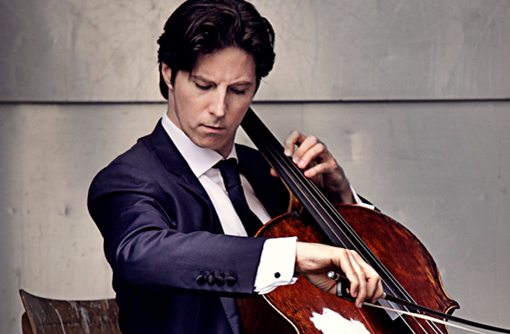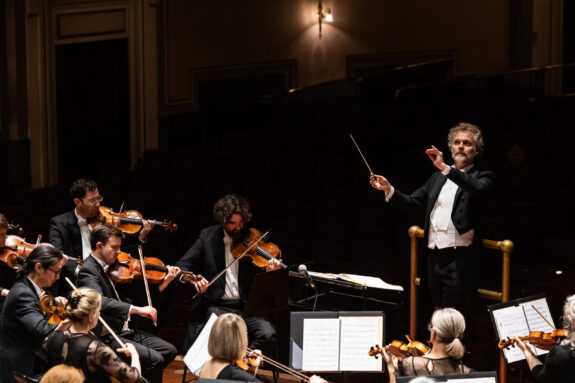 United Kingdom Shostakovich: Daniel Müller-Schott (cellist), Royal Scottish National Orchestra / Thomas Søndergård (conductor). Glasgow Royal Concert Hall, 7.6.2025. (GT)
United Kingdom Shostakovich: Daniel Müller-Schott (cellist), Royal Scottish National Orchestra / Thomas Søndergård (conductor). Glasgow Royal Concert Hall, 7.6.2025. (GT)

Shostakovich – Festive Overture in A major, Op.96; Cello Concerto No.2 in G major, Op.126; Symphony No.11 in G minor, Op.103 ‘1905’
Following the recent Shostakovich Festival in Leipzig, it was ironic that my first concert back home would be of Shostakovich. Yet, Scotland has long had an association with his music, for it was in Edinburgh that his Eighth Symphony was given its UK premiere when Mravinsky brought the Leningrad Philharmonic to the 1960 International Festival. Two years later, the composer himself, together with his son, Maxim, attended the Festival when his music was featured. Several of the symphonies were performed together with chamber recitals of his music, and notably the Scottish composer Ronald Stevenson wrote a solo piano work ‘Passacaglia on DSCH’ which was presented to Shostakovich.
The connection with Shostakovich in Scotland continued when the then Scottish National Orchestra was led by Neemi Järvi, who introduced many lesser-known pieces by Shostakovich to audiences and recorded them, and by Alexander Lazarev who programmed all the fifteen symphonies and recorded several of them including the Eleventh Symphony. The Scottish public have shown their support for Shostakovich whether it be his music for jazz, string quartets or the great symphonies. Indeed, it was with the Eleventh Symphony that Thomas Søndergård made his debut here in 2009, and which led to him being asked to become the Assistant Conductor of the Royal Scottish National Orchestra.
The brief Festive Overture offered a brightly optimistic start and reflected a period of richly veined maturity by the composer, all parts of the orchestra were able to show their mastery and polish, emphasising their affinity with this repertoire. The Second Cello Concerto lacks the introspective and exploring qualities of the composer’s First Concerto for this instrument, yet there are present some of the quirky and more colourful aspects of his creativity in the mid-sixties. In the Largo Mϋller-Schott opened pensively before joined by the low strings; the cadenza was outstanding before the dialogue with the xylophone and the later reprise of the first idea was shattered by the percussion. The highlight of the second movement (Allegretto) were the bizarrely comical citations of an Odessa street song ‘Bubliki’. The finale (Allegretto) highlighted by the strange cadenza with the side-drum emphasised the weirdness of the work as the orchestra joined in with fanfares on the brass and harp glissandos. Ever so slowly, the music began to disappear with Mϋller-Schott playing at the lowest note against the percussion evincing a tick-tock – as if time is passing by. The German cellist played an encore – the Gigue from Bach’s Cello Suite No.3.
In the main work of the evening, the Eleventh Symphony opened (Adagio) with protracted passages intoning several revolutionary songs, played at a slow martial pace, and with colour, most notably voiced on the flute of Katherine Bryan with the song ‘Listen,’ and later by the revolutionary song ‘Prisoner’ heard on the double bass of Nikolai Naumov. Throughout the movement, the tension of the growing menace of the echoing motifs was repeatedly heard on the timpani.
The second movement (Allegro) is based on the composer’s ‘Ten Choral Poems based on Revolutionary Texts’, most significantly, ‘O thou, our Tsar, father’, and ‘Bare your Heads’ intoned by the piccolo of Janet Richardson, and Bryan on the flute bringing great sadness and mourning. Yet the tone quickly changed with the violent transformation by the strings and the brass, especially the trombones, and the tuba, and as the vehemence reached its peak, the tempo switched to a pianissimo on the strings. One of the characteristics of the composer which I noticed in Leipzig recently was the amazing ability of Shostakovich to transform the mood of the symphony in his orchestral canvas, and here under Søndergård’s direction, the finest of musical expression was evinced revealing the RSNO can rival the finest European ensembles.
The third movement (Adagio) echoes the deep mourning for those fallen in the demonstration with the song ‘You fell as victims’ heard clearly in the texture of the strings and woodwind playing. A sign of the composer’s brilliant expression was the section played exclusively by the violas that impelled a fresh upsurge in the tension. The tempo quickly changed in the fourth movement (Allegro non troppo) with an outstanding passage heard on the celesta of Lynda Cochrane, and the intonation of the songs ‘Rage, thee tyrants’. The famous ‘Varshavyanka’ was followed finally by the song ‘Sparks’ before the movingly emotional climax with the ringing of the church bells from Simon Lowden brought a vivid culmination to this moving symphony. Often, this work is dismissed as ‘cinematic’ yet here the Danish conductor revealed it as a masterpiece worthy of greater recognition. This was a triumphant close to the orchestra’s season and augurs well for next season when it will open with Mahler’s Seventh Symphony.
Gregor Tassie
Featured Image: Thomas Søndergård conducts the RSNO © Sally Jubb
